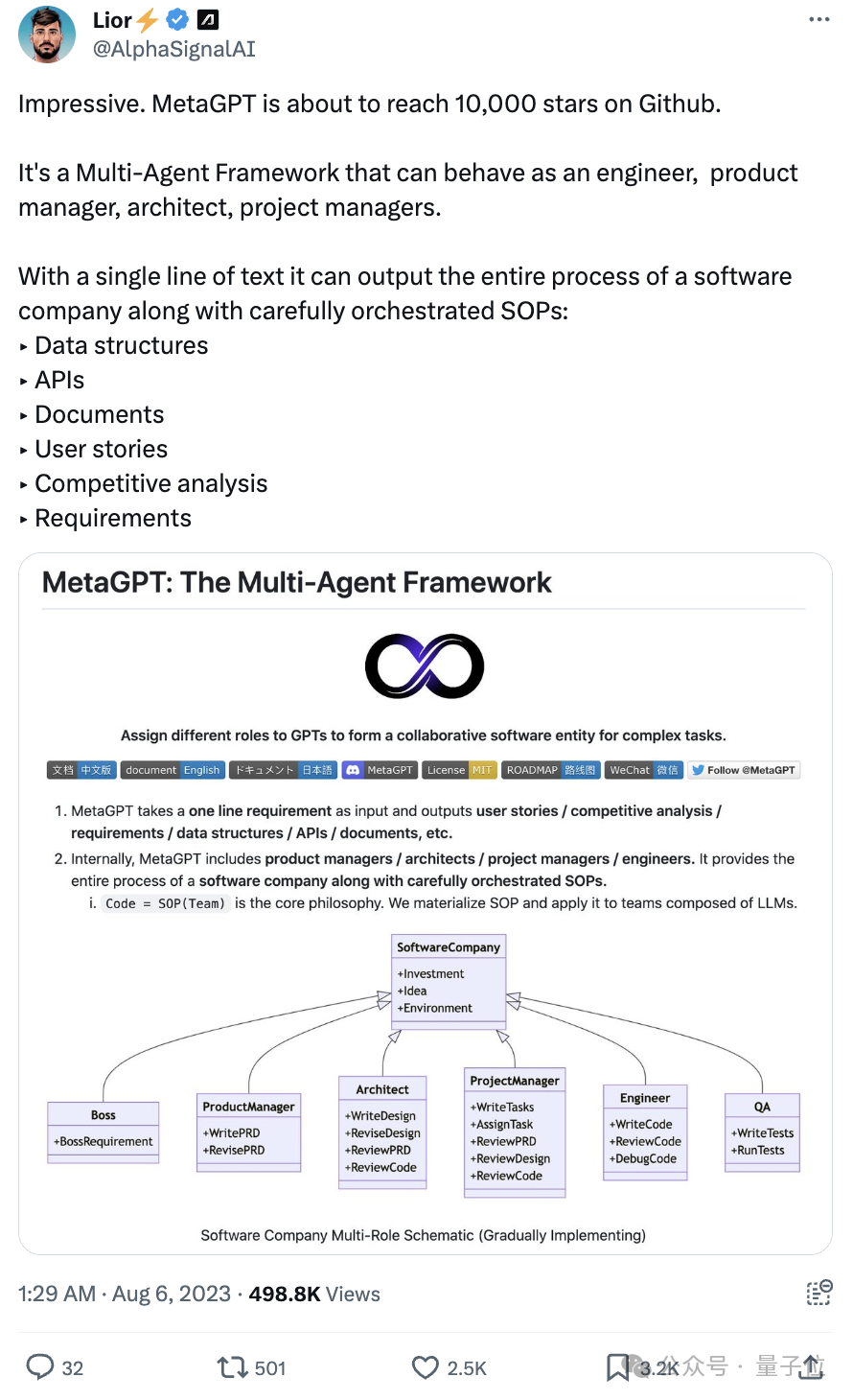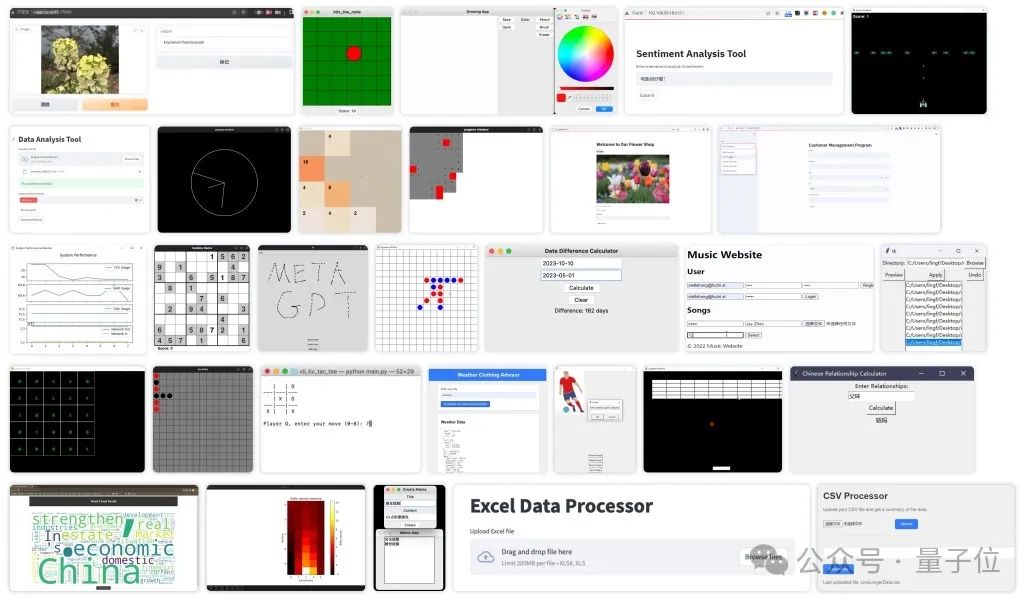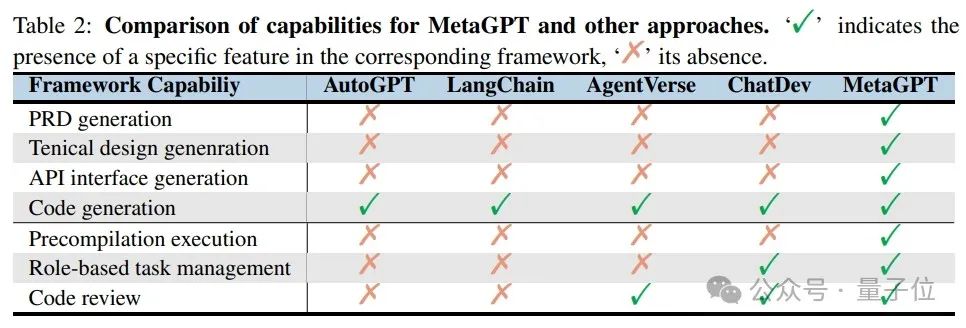 Technology peripherals
Technology peripherals
 AI
AI
 Agents divide work and collaborate like people, and can also exchange information through 'group chat'
Agents divide work and collaborate like people, and can also exchange information through 'group chat'
Agents divide work and collaborate like people, and can also exchange information through 'group chat'
Intelligent agents must also have a "specification manual"!
A study called MetaGPT, by clearly dividing the roles of agents and requiring multiple agents to adopt a unified and standardized "communication format" in collaboration, allows The performance of the agent is greatly improved.
Currently, this research has garnered 33.6k stars on GitHub, and was included as an Oral paper at the top deep learning conference ICLR 2024.

In general, MetaGPT imitates human division of labor and collaboration, and encodes the standard operating procedures of various tasks into the "standards" of intelligent agents. Manual", agents with different roles are responsible for different professional tasks.
For example, the product manager role can use network search tools, while the engineer role can execute code:

In this way, multi-agent collaboration completes the task.
The researchers set up a "message sharing group" for the agents, and the agents can freely view relevant messages sent by other agents.
After testing, using this method, MetaGPT achieved 85.9% and 87.7% new SOTA respectively on the public data sets HumanEval and MBPP for code completion tasks.
Currently this work has been open sourced and has attracted the attention of many netizens across the Internet:

What does MetaGPT look like?
This research was jointly proposed by the DeepWisdom team and scholars from KAUST AI Center, Xiamen University, CUHK(SZ), Nanjing University, UPenn, UCB and many other universities and institutions.

# As the capabilities of large models continue to improve, there is growing interest in academia and industry in using large model-based agents to solve various tasks.
It is worth noting that research on using multiple agents to collaborate to solve problems in specific fields is still in its early stages. Existing research mainly focuses on enhancing task understanding and reasoning decision-making capabilities through role-playing mechanisms and communication topology settings. Despite some progress, these methods still rely on direct dialogue forms and lack standard specifications and constraints on agent behavior.
Some recent work has also pointed out that multi-agent systems based on dialogue may face problems such as information inconsistency, ambiguity, and possible invalid repetition and infinite loops.
In contrast, standard operating procedures (SOPs) in human workflows not only clearly define the division of labor and topology of participating roles, but also establish standard specifications for the role's output results .
Research shows that clearly defined SOPs can improve the consistency and accuracy of task execution and ensure that the end result meets specified quality standards. Therefore, to solve the challenges in multi-agent collaboration, researchers designed a large model-based agent meta-programming framework MetaGPT.
MetaGPT requires agents to participate in collaboration as experts and generate structured output as required, such as high-quality requirements documents, architectural design diagrams, and flow charts.
The structured output is a higher-level thinking chain(Chain-of-Thought) for a single agent, and a context with clear semantics and clear goals for downstream roles(Context).
In the framework of MetaGPT, researchers aligned the concepts of SOPs to role specialization, communication protocol design, and iterative executable feedback design.
Role Specialization
Through clearly defined roles, complex work can be broken down into smaller, more specific tasks.
As shown in the figure below, different professional roles are initialized with different goals and constraints, as well as different professional skills. For example, the product manager role can use web search tools, while the engineer role can execute code. At the same time, each character follows the ReAct behavior pattern by default.

#Role specialization enables each agent to focus on specific tasks within its domain, thereby improving the output quality of large models.
For software development, through the flow of roles, this division of labor more skillfully completes the alignment from natural language to programming language. The character ablation experiment in the paper further proves the effect of this part.
Communication Protocol Design
In practical applications, although natural language has rich semantics, due to its unstructured characteristics, the information is often distorted or even distorted during the message transmission process. Loss of important content.
To solve this problem, the author constrained the agent to participate in collaboration with structured output (including documents and charts) to improve the clarity and completeness of the information. To verify this design, the authors designed a variety of software development tasks to emphasize the criticality of structured output in collaboration through the executability of the generated code and productivity indicators.

In order to improve communication efficiency during multi-agent collaboration, MetaGPT introduces a publish-subscribe mechanism based on message sharing(Publish-Subscribe Mechanism).
As shown in the figure above, the shared message pool allows messages to be exchanged directly, and any agent can transparently access messages from other agents without asking and waiting for a response. The subscription mechanism makes the agent more inclined to receive information related to its own tasks and avoid being distracted by irrelevant details. At the same time, each agent can directly retrieve the required information from the shared message pool to form self-memory.
Executable feedback
The intelligent agent self-optimizes and actively updates based on environmental feedback, which is a manifestation of the intelligent agent's autonomous consciousness.
In terms of software development tasks, MetaGPT has designed an executable feedback mechanism for engineers’ agents to automatically optimize code quality.
Specifically, engineers write and execute corresponding unit test cases, and make decisions and self-prompts recursively through the observed execution results to achieve automatic debugging. This iterative process of design-test-feedback continues until the unit test passes or the maximum number of retries is reached.
Multiple benchmarks test new SOTA
In terms of code generation capabilities, the researchers used two public benchmark data sets: HumanEval and MBPP, and reported the Pass@1 indicator.
In addition, they also collected the SoftwareDev data set covering 70 typical software development tasks (such as mini-games, data visualization, image processing, etc.) , and made multiple agents open source Comparison of frameworks, statistical analysis and qualitative description of the executability and production efficiency of multiple software development tasks.
As shown in the figure below, MetaGPT outperforms previous methods in both the HumanEval and MBPP benchmarks, reaching 85.9% and 87.7% respectively. Compared with the results of GPT-4, MetaGPT has a relative improvement of 28.2% on the HumanEval data set, and adding an executable feedback mechanism has improved 4.2% and 5.4% on HumanEval and MBPP respectively.

On the challenging SoftwareDev dataset, MetaGPT achieves an executability score of 3.75, very close to 4, while requiring a shorter running time(503 seconds);The number of generated lines of code increased by 2.24 times compared to the baseline framework, while the number of tokens consumed per unit line of code dropped by 50%.
These results highlight the efficiency improvements brought by SOPs during multi-agent collaboration.

MetaGPT’s high executability and relatively short running time in software development tasks demonstrate its practicality and efficiency in real-world applications.

Focusing on the field of software development, researchers provide a qualitative comparison of the capabilities of different agent frameworks.
They found that MetaGPT not only has the ability to generate files in multiple modes, but is also the only open source framework among many current frameworks that completely covers the software development process in the real world.

In general, MetaGPT is a novel multi-agent framework that combines meta-programming ideas and embeds SOPs to enhance the capabilities of large models in multi-agent collaboration.
Through role specialization, workflow management and flexible messaging mechanism, it becomes a multi-agent framework with high versatility and portability.
Combined with the iterative feedback mechanism, MetaGPT has achieved SOTA performance on multiple benchmark tests.
SOPs combined with human social practice inspire future research and exploration of multi-agent societies, and can also be regarded as an early attempt to regulate multi-agent frameworks based on large models.
Paper link: https://arxiv.org/abs/2308.00352
Code link: https://github.com/geekan/MetaGPT
The above is the detailed content of Agents divide work and collaborate like people, and can also exchange information through 'group chat'. For more information, please follow other related articles on the PHP Chinese website!

Hot AI Tools

Undresser.AI Undress
AI-powered app for creating realistic nude photos

AI Clothes Remover
Online AI tool for removing clothes from photos.

Undress AI Tool
Undress images for free

Clothoff.io
AI clothes remover

Video Face Swap
Swap faces in any video effortlessly with our completely free AI face swap tool!

Hot Article

Hot Tools

Notepad++7.3.1
Easy-to-use and free code editor

SublimeText3 Chinese version
Chinese version, very easy to use

Zend Studio 13.0.1
Powerful PHP integrated development environment

Dreamweaver CS6
Visual web development tools

SublimeText3 Mac version
God-level code editing software (SublimeText3)

Hot Topics
 1387
1387
 52
52
 Open source! Beyond ZoeDepth! DepthFM: Fast and accurate monocular depth estimation!
Apr 03, 2024 pm 12:04 PM
Open source! Beyond ZoeDepth! DepthFM: Fast and accurate monocular depth estimation!
Apr 03, 2024 pm 12:04 PM
0.What does this article do? We propose DepthFM: a versatile and fast state-of-the-art generative monocular depth estimation model. In addition to traditional depth estimation tasks, DepthFM also demonstrates state-of-the-art capabilities in downstream tasks such as depth inpainting. DepthFM is efficient and can synthesize depth maps within a few inference steps. Let’s read about this work together ~ 1. Paper information title: DepthFM: FastMonocularDepthEstimationwithFlowMatching Author: MingGui, JohannesS.Fischer, UlrichPrestel, PingchuanMa, Dmytr
 The world's most powerful open source MoE model is here, with Chinese capabilities comparable to GPT-4, and the price is only nearly one percent of GPT-4-Turbo
May 07, 2024 pm 04:13 PM
The world's most powerful open source MoE model is here, with Chinese capabilities comparable to GPT-4, and the price is only nearly one percent of GPT-4-Turbo
May 07, 2024 pm 04:13 PM
Imagine an artificial intelligence model that not only has the ability to surpass traditional computing, but also achieves more efficient performance at a lower cost. This is not science fiction, DeepSeek-V2[1], the world’s most powerful open source MoE model is here. DeepSeek-V2 is a powerful mixture of experts (MoE) language model with the characteristics of economical training and efficient inference. It consists of 236B parameters, 21B of which are used to activate each marker. Compared with DeepSeek67B, DeepSeek-V2 has stronger performance, while saving 42.5% of training costs, reducing KV cache by 93.3%, and increasing the maximum generation throughput to 5.76 times. DeepSeek is a company exploring general artificial intelligence
 AI subverts mathematical research! Fields Medal winner and Chinese-American mathematician led 11 top-ranked papers | Liked by Terence Tao
Apr 09, 2024 am 11:52 AM
AI subverts mathematical research! Fields Medal winner and Chinese-American mathematician led 11 top-ranked papers | Liked by Terence Tao
Apr 09, 2024 am 11:52 AM
AI is indeed changing mathematics. Recently, Tao Zhexuan, who has been paying close attention to this issue, forwarded the latest issue of "Bulletin of the American Mathematical Society" (Bulletin of the American Mathematical Society). Focusing on the topic "Will machines change mathematics?", many mathematicians expressed their opinions. The whole process was full of sparks, hardcore and exciting. The author has a strong lineup, including Fields Medal winner Akshay Venkatesh, Chinese mathematician Zheng Lejun, NYU computer scientist Ernest Davis and many other well-known scholars in the industry. The world of AI has changed dramatically. You know, many of these articles were submitted a year ago.
 Hello, electric Atlas! Boston Dynamics robot comes back to life, 180-degree weird moves scare Musk
Apr 18, 2024 pm 07:58 PM
Hello, electric Atlas! Boston Dynamics robot comes back to life, 180-degree weird moves scare Musk
Apr 18, 2024 pm 07:58 PM
Boston Dynamics Atlas officially enters the era of electric robots! Yesterday, the hydraulic Atlas just "tearfully" withdrew from the stage of history. Today, Boston Dynamics announced that the electric Atlas is on the job. It seems that in the field of commercial humanoid robots, Boston Dynamics is determined to compete with Tesla. After the new video was released, it had already been viewed by more than one million people in just ten hours. The old people leave and new roles appear. This is a historical necessity. There is no doubt that this year is the explosive year of humanoid robots. Netizens commented: The advancement of robots has made this year's opening ceremony look like a human, and the degree of freedom is far greater than that of humans. But is this really not a horror movie? At the beginning of the video, Atlas is lying calmly on the ground, seemingly on his back. What follows is jaw-dropping
 KAN, which replaces MLP, has been extended to convolution by open source projects
Jun 01, 2024 pm 10:03 PM
KAN, which replaces MLP, has been extended to convolution by open source projects
Jun 01, 2024 pm 10:03 PM
Earlier this month, researchers from MIT and other institutions proposed a very promising alternative to MLP - KAN. KAN outperforms MLP in terms of accuracy and interpretability. And it can outperform MLP running with a larger number of parameters with a very small number of parameters. For example, the authors stated that they used KAN to reproduce DeepMind's results with a smaller network and a higher degree of automation. Specifically, DeepMind's MLP has about 300,000 parameters, while KAN only has about 200 parameters. KAN has a strong mathematical foundation like MLP. MLP is based on the universal approximation theorem, while KAN is based on the Kolmogorov-Arnold representation theorem. As shown in the figure below, KAN has
 The vitality of super intelligence awakens! But with the arrival of self-updating AI, mothers no longer have to worry about data bottlenecks
Apr 29, 2024 pm 06:55 PM
The vitality of super intelligence awakens! But with the arrival of self-updating AI, mothers no longer have to worry about data bottlenecks
Apr 29, 2024 pm 06:55 PM
I cry to death. The world is madly building big models. The data on the Internet is not enough. It is not enough at all. The training model looks like "The Hunger Games", and AI researchers around the world are worrying about how to feed these data voracious eaters. This problem is particularly prominent in multi-modal tasks. At a time when nothing could be done, a start-up team from the Department of Renmin University of China used its own new model to become the first in China to make "model-generated data feed itself" a reality. Moreover, it is a two-pronged approach on the understanding side and the generation side. Both sides can generate high-quality, multi-modal new data and provide data feedback to the model itself. What is a model? Awaker 1.0, a large multi-modal model that just appeared on the Zhongguancun Forum. Who is the team? Sophon engine. Founded by Gao Yizhao, a doctoral student at Renmin University’s Hillhouse School of Artificial Intelligence.
 Kuaishou version of Sora 'Ke Ling' is open for testing: generates over 120s video, understands physics better, and can accurately model complex movements
Jun 11, 2024 am 09:51 AM
Kuaishou version of Sora 'Ke Ling' is open for testing: generates over 120s video, understands physics better, and can accurately model complex movements
Jun 11, 2024 am 09:51 AM
What? Is Zootopia brought into reality by domestic AI? Exposed together with the video is a new large-scale domestic video generation model called "Keling". Sora uses a similar technical route and combines a number of self-developed technological innovations to produce videos that not only have large and reasonable movements, but also simulate the characteristics of the physical world and have strong conceptual combination capabilities and imagination. According to the data, Keling supports the generation of ultra-long videos of up to 2 minutes at 30fps, with resolutions up to 1080p, and supports multiple aspect ratios. Another important point is that Keling is not a demo or video result demonstration released by the laboratory, but a product-level application launched by Kuaishou, a leading player in the short video field. Moreover, the main focus is to be pragmatic, not to write blank checks, and to go online as soon as it is released. The large model of Ke Ling is already available in Kuaiying.
 FisheyeDetNet: the first target detection algorithm based on fisheye camera
Apr 26, 2024 am 11:37 AM
FisheyeDetNet: the first target detection algorithm based on fisheye camera
Apr 26, 2024 am 11:37 AM
Target detection is a relatively mature problem in autonomous driving systems, among which pedestrian detection is one of the earliest algorithms to be deployed. Very comprehensive research has been carried out in most papers. However, distance perception using fisheye cameras for surround view is relatively less studied. Due to large radial distortion, standard bounding box representation is difficult to implement in fisheye cameras. To alleviate the above description, we explore extended bounding box, ellipse, and general polygon designs into polar/angular representations and define an instance segmentation mIOU metric to analyze these representations. The proposed model fisheyeDetNet with polygonal shape outperforms other models and simultaneously achieves 49.5% mAP on the Valeo fisheye camera dataset for autonomous driving



